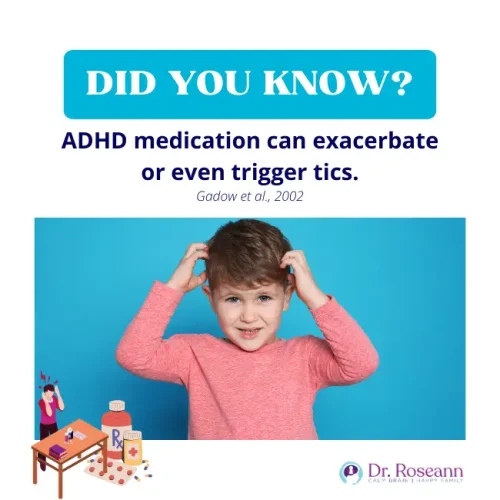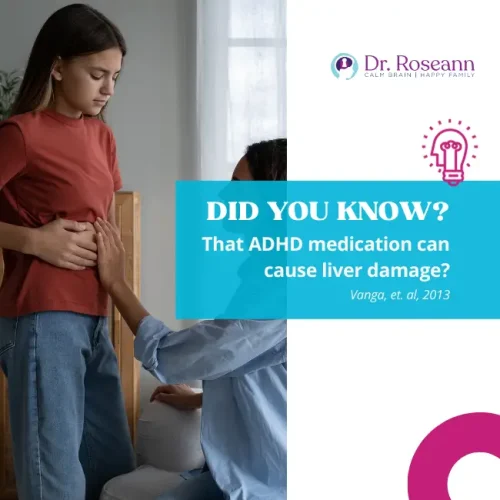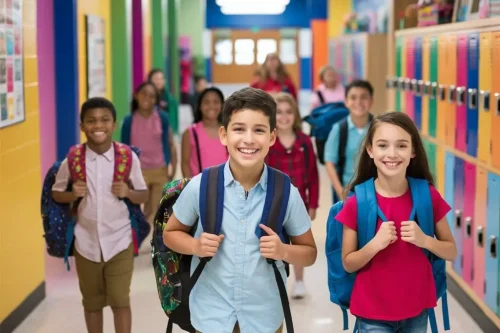Estimated reading time: 7 minutes
Parents often feel stuck when it comes to ADHD medication.
On one hand, you see your child struggling—whether it’s with focus, schoolwork, or friendships—and the idea of medication feels like the fastest way to help.
On the other hand, the worry about side effects, long-term impact, and whether medicine actually addresses the root issue can weigh heavily. It’s no wonder so many parents feel torn, unsure of what “the best” choice really is.
The truth? ADHD isn’t just about behavior—it’s about a dysregulated brain. When we calm the brain first, everything else gets easier.
In this blog, I’ll break down the real risks and benefits of ADHD medication for kids, answer the questions parents ask me most, and share natural supports that calm the brain first.
What Types of ADHD Medication Are Available for Kids?
Parents often sit with two feelings at once—hope for relief and worry about risks. ADHD medications generally fall into two groups:
- Stimulants (Ritalin, Adderall): Often work quickly to improve focus and impulse control.
- Non-stimulants (Strattera, Intuniv): Useful when stimulants cause sleep or appetite issues, or simply don’t work.
What Parents Should Know
- No single pill helps every child.
- Side effects can range from mild to disruptive.
- Doses usually need adjusting over time.
Medication may calm symptoms but doesn’t fix nervous system dysregulation.
I’ve watched some families breathe easier with the right prescription while others find the process of adjustments draining.
That’s why my guidance never changes: calm the brain first, and everything else follows. Because behavior is communication—and regulation is the solution
How Do ADHD Medications Work in the Brain?
ADHD medications work on two key brain chemicals that shape focus and self-control: dopamine and norepinephrine.
- Stimulants: Boost these chemicals quickly, often improving attention fast.
- Non-stimulants: Adjust them more gradually, sometimes with fewer side effects.
Terminology Made Simple
| Neurotransmitters | messengers that help brain cells communicate |
| Dopamine | drives motivation and focus |
| Norepinephrine | sharpens alertness and impulse control |
Case Example
Sarah, mom of a 9-year-old, noticed her son’s teacher praised his improved focus after starting stimulants. At home, though, she saw appetite loss. Her story shows why close monitoring matters—because every child’s nervous system responds differently.
Medication can help a child “tune in,” yet it doesn’t resolve the root issue of nervous system dysregulation. Calm the brain first, everything follows.
What Are the Short-Term Benefits of ADHD Medication?
Many parents see improvement within days or weeks. Benefits can include:
- Better focus in school
- Reduced impulsivity
- Improved ability to follow directions
- Less classroom disruption
But remember: medication alone doesn’t teach self-regulation skills. It’s a tool—not a cure.
True progress happens when we calm the brain first, because behavior is communication. With regulation, kids gain the foundation they need to build lasting focus and emotional resilience.
What Side Effects Should Parents Watch Out For?
ADHD meds can help many kids, and yet parents still ask, “What should I watch for?” It’s a smart question—spotting side effects early helps you and your provider make the best decisions for your child.
Common Side Effects of ADHD Medication
- Decreased appetite: Mealtimes can feel like a struggle.
- Sleep struggles: Trouble falling or staying asleep can worsen symptoms.
- Weight loss: Track changes in clothing fit and growth charts.
- Stomach upset: Nausea or bellyaches may appear; the gut–brain axis links GI health with behavior (Checa-Ros et al., 2021).
- Mood swings: Irritability, sadness, or anxiety can emerge (Grahame-Smith, 1975).
- Tics: Some children develop or notice more repetitive movements or sounds (Gadow et al., 2002).

More Serious Risks
- Heart concerns: Chest pain or irregular heartbeat needs prompt evaluation.
- High blood pressure: Regular checks add safety.
- Personality shifts: If your child seems “not themselves,” more anxious or withdrawn—call your provider.
- Growth delays: Long-term weight loss can slow growth; monitor height and weight.
- Liver issues: Rare, but some clinicians order liver function tests (Vanga et al., 2013).

I’ve personally seen medication bring real calm, and I’ve also seen side effects that left families searching for better answers. Remember: you’re not failing—it’s not bad parenting, it’s a dysregulated brain.
Behavior is the symptom, nervous system dysregulation is the root. When we calm the brain first, everything else follows.
Are There Long-Term Risks of ADHD Medication for Kids?
Short-term calm doesn’t always mean long-term progress.
What parents need to know:
- Tolerance: Some kids eventually need higher doses, like sneakers that wear thin with use.
- Stigma: Medication labels can feel heavy, leaving kids worried they’re defined by a pill.
- Dose changes: Sudden shifts in stimulant levels may bring mood changes.
- Cumulative side effects: Appetite, sleep, or growth concerns can build over months or years.
That doesn’t mean medication has no role. It means steady teamwork with providers, regular check-ins, and honest talks with your child are key.
Remember—you’re not failing, you’re navigating a unique nervous system. Every brain writes its own story. It’s not misbehavior—it’s dysregulation. Calm the brain first, and everything else follows.
Managing Side Effects of ADHD Medication
Watching your child on ADHD medication can sometimes feel like being a detective. Small clues—mood dips, appetite shifts, restless nights—often tell a bigger story. And those clues give us the power to support the brain better.
Here are a few places where parents can keep steady watch:
- Meals matter: If hunger fades, keep snacks predictable and nutrient-packed. Growth depends on fuel.
- Bedtime battles: A calm nightly rhythm helps the brain switch gears. Screens off, lights down, body still—because calm comes first.
- Hydration and movement: Water and daily play keep energy flowing and side effects lower.
- Classroom support: Teachers see patterns you might miss at home. Ask them, involve them, lean on them.
Parents often ask me, “Does this mean I’m failing if my child struggles with medication?” Absolutely not.
What you’re seeing isn’t bad parenting—it’s a dysregulated brain asking for support. And when we calm the brain first, everything else follows.
Are There Natural or Non-Medication Alternatives for ADHD?
Parents often lean in and ask me, “What else can we do besides medication?” Fair question. You’re not alone in wanting options that heal without relying only on a pill.
The truth? Science backs plenty of other approaches that calm a child’s brain while teaching lifelong skills.
Here are some powerful paths forward:
- Behavior therapy: Kids learn tools for self-control — like filling a toolbox with strategies to manage impulsivity.
- Family therapy: ADHD doesn’t land on just one child’s shoulders. Everyone at home feels the ripple, and this work helps the whole crew.
- Social skills training: A safe space where kids practice making friends, reading cues, and problem-solving without judgment.
- Parent training: Gives you real strategies like structure, consistency, and positive reinforcement—because kids thrive when parents have a plan.
- Educational support: With IEPs or 504 plans, schools can meet kids where they are. Simple shifts like extra time or flexible seating can make a huge difference.
Now let’s not forget lifestyle. A colorful plate of nourishing food, steady sleep, and regular bursts of exercise can shift mood and focus in big ways. Small tweaks often ripple into real progress.
And then there are cutting-edge tools like neurofeedback and PEMF. These don’t just mask symptoms—they help retrain the brain itself. When the nervous system learns to regulate, attention and calm become skills kids can carry for life.
How Do I Know if ADHD Medication Is Right for My Child?
This may be the hardest question parents face—and only you, your child, and your provider can answer it together.
Questions worth asking yourself:
- Is my child’s daily functioning improving or sliding backward?
- Do side effects outweigh the benefits?
- Have we tried regulation-first supports alongside medication?
Case example:
Monica, mom of a 10-year-old, felt rushed toward medication. She chose to start with lifestyle changes and therapy. Later, a low-dose stimulant became part of a bigger plan—not a quick fix.
Takeaway:
ADHD medication should fit into a whole-child approach, not act as the only solution.
Parents often ask me what’s best. Truth is, nutrition, brain supplements, and natural therapies can powerfully shape brain health—especially for developing children whose brains remain deeply influenced by their environment. Medication may help some, but it shouldn’t be the automatic first step.
Risks parents must weigh carefully:
- Substance use: Research shows ADHD medication can lower long-term substance abuse risk, though results vary (CDC, 2022).
- Dependency: Stimulants carry some misuse potential.
- Side effects: Appetite loss, sleep struggles, and mood shifts may build over time.
That’s why alternatives matter. Programs like my BrainBehaviorResetTM Program combine neurofeedback, PEMF, magnesium, and behavioral therapy to calm the brain and build skills—without the same risks as medication.
The American Academy of Pediatrics is clear: for young children, behavioral therapy and natural supports should come first (CDC, 2022). You’re not failing if you want to explore those paths—because when we calm the brain first, everything else follows.
Parent Action Steps
FAQs
Do all kids with ADHD need medication?
No. Some children do well with therapy, lifestyle changes, and brain regulation strategies alone. Every child is unique, and medication should never be the automatic first step. Many kids thrive when parents focus on calming the nervous system and building lasting coping skills.
Can ADHD meds change my child’s personality?
They shouldn’t. Medication is meant to support focus and regulation—not make your child feel “flat” or unlike themselves. If you notice concerning changes in mood or personality, it’s important to speak with your provider about adjusting the dose or exploring alternatives.
Can medication be stopped later?
Yes. Many families reevaluate their child’s medication plan during adolescence or as new coping skills develop. With medical guidance, tapering or stopping medication is often possible. The key is to regularly reassess whether medication is still serving your child’s needs and overall well-being.
Citations
CDC. (2022, August 9). Treatment of ADHD. Centers for Disease Control and Prevention. https://www.cdc.gov/ncbddd/adhd/treatment.html
Checa-Ros, A., Jeréz-Calero, A., Molina-Carballo, A., Campoy, C., & Muñoz-Hoyos, A. (2021). Current Evidence on the Role of the Gut Microbiome in ADHD Pathophysiology and Therapeutic Implications. Nutrients, 13(1), 249. https://doi.org/10.3390/nu13010249
Gadow, K. D., Nolan, E. E., Sprafkin, J., & Schwartz, J. (2002). Tics and psychiatric comorbidity in children and adolescents. Developmental Medicine & Child Neurology, 44(05). https://doi.org/10.1017/s001216220100216x
Grahame-Smith, D. G. (1975). Self-medication with mood-changing drugs. Journal of Medical Ethics, 1(3), 132–137. https://doi.org/10.1136/jme.1.3.132
Vanga, R. R., Bal, B., & Olden, K. W. (2013). Adderall induced acute liver injury: a rare case and review of the literature. Case reports in gastrointestinal medicine, 2013, 902892. https://doi.org/10.1155/2013/902892
Dr. Roseann is a mental health expert in ADHD who frequently is in the media:
- Helping Children Thrive Podcast Benefits of Neurofeedback for children with ADHD
- She Knows 11 Products Moms of Kids With ADHD Swear By to Maintain Order in the Chaos
- The Healthy 12 Silent Signs of Adult ADHD You Might Be Ignoring
- It’s Gonna Be OK! Podcast ADHD Series
Always remember… “Calm Brain, Happy Family™”
Are you looking for SOLUTIONS for your struggling child or teen?
Dr. Roseann and her team are all about science-backed solutions, so you are in the right place!
Grab your complimentary copy of








